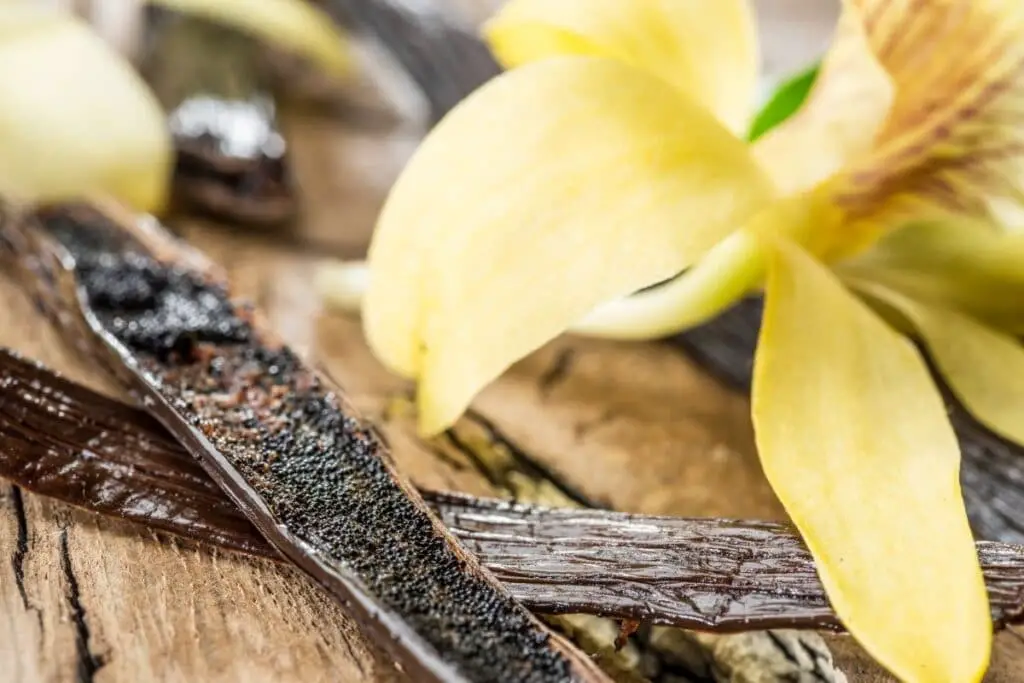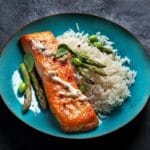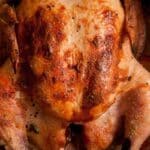Key points:
- Vanilla beans are the fruit of the vanilla orchid plant, providing a rich and sweet aroma that enhances various products, from baked goods to perfumes.
- They’re obtained from the pods of the vanilla orchid, and while they are labor-intensive to cultivate, they are highly versatile and aromatic.
- To use a vanilla bean, you slit it open and scrape out the flavorful seeds. The skin of the bean is edible and can be used to make vanilla-scented sugar.
- While vanilla beans are more expensive and intricate to use than artificial vanilla essence, their complex flavor profile and aromatic qualities make them a valuable ingredient in various culinary and cosmetic creations.
Many baking recipes call for vanilla essence. This easy-to-come-by artificial essence is an affordable way to add a rich and sweet vanilla flavor to your baked goods instead of breaking the bank by using authentic vanilla beans.
The artificial essence resembles the flavor of much more expensive vanilla beans, which are always preferable, but not always affordable or available.
Vanilla beans are the inspiration behind all things vanilla. From ice cream, cakes, frosting, and puddings to perfumes and cosmetics, vanilla beans are a versatile sweet and deeply aromatic spice. So what are vanilla beans and where do they come from? Let’s find out.
What are Vanilla Beans?
Vanilla is a spice obtained from pods of a vanilla orchid plant. It is the second most expensive spice in the world due to the labor-intensive cultivation process. Three main species of the spice are grown worldwide with the most common type being known as Madagascar or Bourbon vanilla.
This type is grown in Madagascar, its neighboring islands in the Indian Ocean as well as in Indonesia.
The spice grows as a vine either on trees, on poles in a plantation, or in a shade house. The aromatic compounds are found in beans which grow as a result of the pollination of the flowers.
Vanilla beans are essentially seed pods that are approximately a third of an inch (8 mm) wide and six inches (15 cm) long when mature with a green, yellow or brownish appearance. Inside these pods is an oily paste full of tiny seeds.
Vanilla Bean Cultivation
The flowering of the vines occurs every spring. Without pollination, the flowers will wilt and no beans will grow. In the wild, the only insects ever observed pollinating these flowers are orchid bees.
These bees are rare and even in the places they are found, there is only a 1% chance of successful pollination. As a result, all commercial vanilla is pollinated artificially by hand to ensure the production of the fruits without the presence of the bees.
The flowers only last one day and must be hand-pollinated within 12 hours of opening. This means that growers have to inspect plantations every day for open flowers. Growers only pollinate the first five or six flowers that open from around 20 on each vine. This allows beans of a similar age to grow together, facilitating harvest and ensuring good bean quality.
Over-pollination will result in disease and poor quality. The pods require approximately five to six weeks to develop, and six months to reach maturation. The plants remain seasonally productive for 12 to 14 years with healthy vines producing 50 to 100 pods per year.
Spice Harvesting and Commercial Value
To ensure the best market value and quality fruit, each individual pod is picked by hand when ripe. The commercial value of the spice is dependent on the length and appearance of the bean.
If the bean is more than 5.9 inches (15 cm) in length, it is a first-quality category bean. Larger beans that are 6.3 to 8.3 inches (16 cm to 21 cm) long are usually reserved for the gourmet vanilla market selling to top chefs and restaurants.
Beans that are between 3.9 inches and 5.9 inches (10 to 15 cm) long, are classified as second-quality pods and those less than 3.9 inches (10 cm) in length are classified as third-quality.
Each pod contains thousands of very small black seeds. Both the seeds and the pod can be used in cooking using various techniques.
Younger vines that are around five years old can produce between 3.3 and 6.6 lb (1.5 to 3 kg) of pods. After a few years, this can increase up to 13 pounds (6 kg). The harvested green beans can be commercialized as such but are often cured to obtain a better market price.
See more: Vanilla Extract Substitute
Curing Vanilla Beans
The four steps involved in curing vanilla beans are killing, sweating, slow-drying, and conditioning of the pods.
#1. Killing
This is similar to blanching the beans to stop the enzymatic action and vegetative growth. Within the three days following their harvest, the beans are submerged in hot water for a short period ranging between 10 seconds and 3 minutes.
The timing depends on the bean size and condition as well as the water temperature.
Besides preventing further growth, the process also initiates enzyme release which converts glycovanillin into vanillin, starting the vanillin production. This is the primary flavor component of the bean.
Although killing is often done by dipping the pods into hot water it can also be achieved through freezing or scratching the beans along their length. Another method used is exposing the fruits to sunlight or heating in a low-temperature oven.
#2. Sweating
Straight after being removed from the water beans are wrapped in wool blankets and stored in a dark, airtight container. Doing this quickly is important to preserve the steam and heat, triggering more enzyme activity to continue the conversion of starches to vanillin, along with other complex components responsible for the gorgeous, sweet aroma.
The sweating phase lasts up to two weeks, where all of the beans remain tightly wrapped and need to be kept warm since any cooling could trigger mold growth. Once the vanilla beans develop a good moisture content, they are exposed to air which is fundamental to the transformation of the flavor and to further prevent mold.
The process of unrolling the beans for sunlight exposure during the day and rolling them back up at night or when rain clouds loom continues for approximately two months.
#3. Drying
Drying is potentially the most problematic of the curing stages. The drying process is essential to enable international shipping and can take as long as four weeks. Beans that are too moist will develop mold during shipping.
The pods are laid out in the open air and moved between the shade and sun. Too much sunlight can result in over-drying that will destroy the vanillin and make the pods pretty useless. To prevent this the pods are closely monitored and arranged by moisture content.
Optimally the pods will achieve a moisture content of 25 to 30 percent. Workers sometimes massage the pods individually by hand to facilitate even drying.
#4. Conditioning
Conditioning takes place over a five to six-month period where the pods are sorted, bundled, wrapped, and preserved for the development of the flavor and aroma. The cured pods contain 2.5% vanillin on average.
Grading
Once completely cured, the beans are graded on quality. Although there are different grading systems in place, the grade is generally based on the length, color, splits or blemishes, and moisture content. Somewhat oily pods that are dark, plump, and visually attractive, with no blemishes, are graded highly.
Beans that have any physical defects are cut to remove the blemishes. They are assigned lower grades, and often used in the production of vanilla extract and fragrances.
How To Use A Vanilla Bean
Step 1: Set the whole bean on a cutting board flat side down. Place the tip of a sharp knife just below the curled top of the vanilla bean.
Step 2: Cut down the middle of the bean from top to bottom, slicing only the top layer without penetrating the bottom layer of the skin.
Step 3: Slightly open up the slit and run the knife blade side down from the top to the bottom of the bean, scraping out the seed paste.
Once the seeds have been scraped out of the pod, don’t throw the pod away. Place the scraped pod into a jar with sugar and let it infuse to make subtle vanilla-scented sugar that can be used in baking or coffee.
FAQs
Is the skin of a vanilla bean edible?
Yes, the skin of a vanilla bean, also known as the pod or casing, is edible and contains the flavorful seeds that are commonly used in cooking and baking.
How can you tell if a vanilla bean is off?
A vanilla bean that is off or spoiled may exhibit signs such as mold, an unpleasant odor, or a dried-out and brittle texture. Fresh vanilla beans should have a pliable feel, a strong and sweet aroma, and a dark, glossy appearance.
Do vanilla beans expire?
Yes, vanilla beans can expire over time. While they have a relatively long shelf life, they can dry out, lose flavor, and become less aromatic as they age. Proper storage in an airtight container in a cool, dark place can help extend their usable life.
Conclusion
With such an intricate and lengthy production process it is no surprise that vanilla beans are high in price and highly prized. Next time you bake a rich vanilla cake or whip up a vanilla ice cream with pure vanilla specs in it, appreciate the lengthy process those beans have been through to get to your table.
Up next:
*image by Valentyn_Volkov/depositphotos









